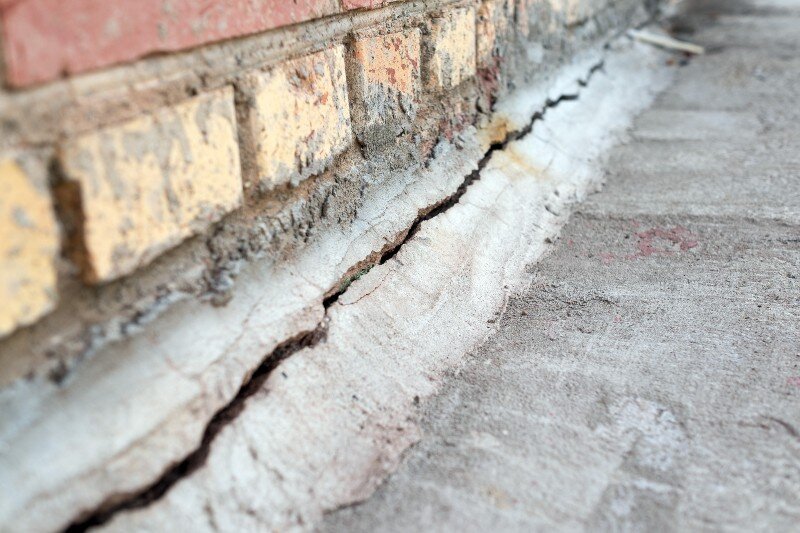
Homeowners tend to worry a lot about the decoration of the house and how clean it is. What about the foundation of the house? Eventually, cracks and holes will appear and the foundation of any home. Do you know how to fix them?
We will explain all the steps necessary to fix major cracks and repair your foundation.
You will also find out how to identify foundation problems and discover the different types of foundation cracks possible in your real estate property and how to complete foundation crack repair projects.
Are you ready to find out how to fix foundation cracks in your house?
How to Fix Foundation Cracks
If you have concrete walls and a block foundation in your basement, you may need to monitor them for any cracks.
If the house has cracks larger than one-eighth of an inch, you may need a concrete crack sealer or a repair kit.
Fill the crack with the sealer to prevent the foundation issues from expanding.
If you see any hairline cracks, you do not need to worry.
Hairline cracks are often due to a foundation settlement. Basement corners, windows, and doors will see the most hairline cracks. Fix these tiny hairline cracks by adding a coat of acrylic paint.
If you see a new narrow crack in your walls or floors, you should wait before using caulk to repair it. You should monitor the crack to see if it expands beyond one-eighth of an inch.
The crack may occur due to the house settling, but you should keep an eye on it. Use a tape measure to assess the size of the crack and take photos of the breakage on different dates. Check the size of the crack once per month for several months.
If it remains stable and does not expand, use grout sealant like Sashco Gray Mor-Flexx Grout Repair and drywall to fill the wall cracks. Using putty knives to smooth horizontal cracks is your best option.
Identifying Foundation Cracks
Are you looking to complete a home sale? Then, you will need to conduct specific house repairs before selling a house. Identifying and repairing foundation cracks are at the top of the list.
Structural cracks may not show themselves freely. Home foundation issues like unevenness may occur. When identifying larger cracks in your basement walls and concrete foundation, you must focus on everything.
Consider the following:
- A door getting stuck or failing to close and lock
- Cracks showing up in doorways, windows, on in the ceilings
- Ceramic tile cracks in the concrete floors
- Windows are difficult to open or will not close fully
You should also check out the outside to see if there are any horizontal or vertical cracks in your concrete foundation. Look beyond your landscaping and bushes or trees. Make sure that the walls are mostly straight on both sides. You can use a level to measure whether the walls became uneven.
Did you find any bulges or curves in the foundation? If so, the house may have shifted. The earth around the home may have also shifted and expanded. The walls of the house get pressurized after that type of shift.
You can also identify foundational issues by probing the concrete for any weak spots. Use a screwdriver to poke the concrete and determine its strength, especially if the concrete has begun chipping. The foundation wall or concrete floor should remain strong enough so that you can’t damage them.
If you’re able to chip off any bit of concrete, the foundation may have begun deteriorating. Unfortunately, if that occurs, you will need to complete a large foundation repair project to fix the structural problems, such as installing a new foundation. It may be the only way to improve the structural integrity of your house.
You should also check concrete supports and beams to ensure they’re standing up straight. The beams need to position themselves firmly on the bottom of concrete piers.
Different Types of Foundation Cracks to Fix
There are numerous types of foundation cracks you may find in your house, such as:
- Hairline cracks
- Concrete cracks larger than one-eighth of an inch
- Stair-step cracks
- Horizontal cracks
- Vertical cracks
Do you see hairline cracks after the first year of home construction? If so, you probably won’t need to choose any repair method. Often, these small cracks are due to the house settling and won’t grow any larger. Whenever the cracks grow larger or water seeps through the holes, you may need an expert to help fix the foundation issues.
Once again, you can use a measuring tape and check on the cracks every month to see if they’re growing in size. Over time, you will see if the issue is due to the foundation settling or a larger problem.
You will especially need to fix cracks larger than one-eight of an inch. Vertical or horizontal cracks are the most common possibilities in a foundation wall.
Since concrete shrinks when the foundation is settling, the cracks that appear are called shrinkage cracks. Such cracks often show up vertically across the concrete and tend to be less than one-eighth of an inch.
However, if such a vertical crack is found near a corner and grows larger than one-eighth of an inch, it may indicate a larger foundational issue. If you do see a vertical crack that’s relatively large, you should call an expert to get it inspected.
Unlike vertical cracks, the typical horizontal cracks often indicate a problem right away, even if they’re relatively small. Horizontal cracks occur due to hydrostatic pressure, otherwise known as water pressure. That type of pressure causes major issues for the walls and damages the foundation.
Generally, the foundation is built to handle the pressure caused by water and soil during rainstorms. However, heavy rains and flooding may lead to significant horizontal cracks. You will need to repair horizontal cracks right away before the foundation issues grow more severe.
Furthermore, cracks that change direction, sloping floors, or bulging walls indicate serious foundational issues. Such issues need to get fixed right away to prevent your foundation from collapsing. If you see your walls start bulging after a heavy storm and/or flooding, call a professional right away to fix your foundation.
Ways to Fix Foundation Cracks on Your House
You will need to take several steps to fix foundation cracks in the cement and concrete of your walls or floors. First, you will need to repair a foundation crack using an epoxy sealer to seal the holes. You may need to use a liquid concrete repair kit.
The next step is to block out the injection ports using finishing nails spaced 12 inches apart. The nails will align the injection ports via the crack. Next, you’ll need to mix the epoxy crack sealer. Take out two containers of epoxy sealer and take out two equal parts from each container.
You may also want to use two different sticks to prevent contamination. Blend using a clean putty knife until the color turns grey. Add the sealer onto the injection ports and press the plastic ports over the nail.
Now, you can spread the sealing agent across the crack. Make sure to create a larger batch of the epoxy sealing agent and put it along the whole crack using a 1.5-inch putty knife. Spread the sealer about one inch on both sides of the crack. Only leave the neck part of the injection ports.
Leave the sealer for six to ten hours to cure. Next, you will need to inject epoxy into the crack. Use the plunger rod to mix LCR epoxy and then place it into a caulk gun. Now, you can start at the bottom and move up to inject the epoxy in every bit of the crack.
The last two steps include sealing up injection ports with epoxy and then cutting away the injection ports. These steps are the main ways to fix foundation cracks in your home.
Conclusion
After reading the guide above, you should understand perfectly well how to fix foundation cracks in your home’s concrete structures. You will need to identify the foundational issues that truly need repair and not worry about the smaller hairline cracks.
You may want to hire a structural engineer and contractor to fix any major hydraulic cement cracks and work on waterproofing your place. You can also DIY smaller projects including epoxy injection repairs to fill minor cracks. Often, the costs to sell a house include home repairs like these.
However, if you would prefer to sell your home in its as-is condition, you may want to find a cash home buyer. If you’re selling a Pennsylvania house, seek out cash home buyers in Pennsylvania.
Want to sell a house fast in Aston? Check out the many real estate investors and cash buyers in your area. Luckily, we buy houses Philadelphia residents enjoy, so call us today!


 Call Us!
Call Us!